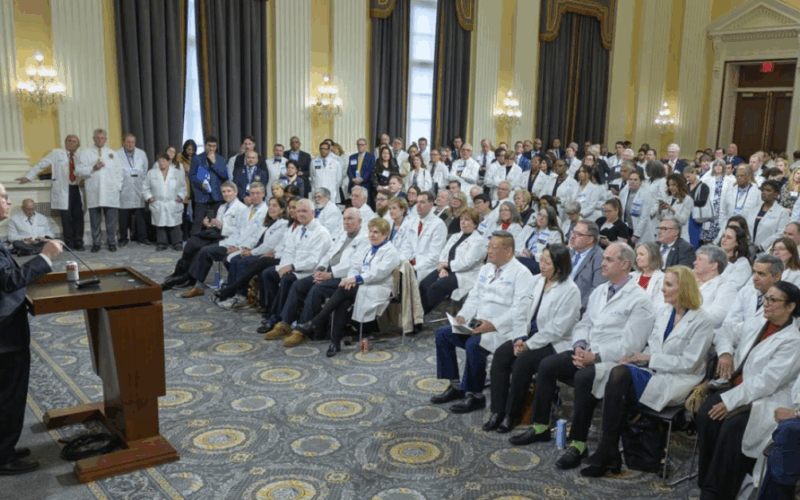Washington, D.C. – The American Medical Association (AMA) has expressed strong support for a new Senate bill aimed at stabilizing Medicare payments by providing a temporary 2% boost to Medicare physician payments in 2025. This move comes as a critical response to the recent 2.83% cut to the Medicare Physician Fee Schedule Conversion Factor (MPFS) that took effect in January 2025.
The Medicare Patient Access and Practice Stabilization Act of 2025 (S. 1640), introduced by Senator Roger Marshall, MD (R-Kan.), seeks to not only reverse this payment cut but also implement a positive update to ease financial pressures on physician practices across the United States.
A Vital Step to Reverse Medicare Payment Cuts
Since January 2025, physicians have faced a 2.83% reduction in Medicare payments, aggravating ongoing challenges in sustaining physician practices nationwide. The proposed Senate bill aims to reverse the cut fully and add a 2% payment update from June through December 2025, providing a much-needed reprieve to healthcare providers.
According to James L. Madara, MD, AMA’s executive vice president and CEO, in a letter to Senator Marshall, the legislation “offers physician practices a temporary but important reprieve” and helps practices endure inflationary cost pressures such as rising expenses for electricity, insurance, and medical supplies.
“Without immediate legislative intervention, this growing disparity will further destabilize independent practices, accelerate market consolidation, and threaten access to care, particularly in rural and underserved communities.” – Dr. James L. Madara
Bipartisan Support and Broader Legislative Efforts
The Senate bill has a bipartisan counterpart in the House, H.R. 879, introduced by Representatives Greg Murphy, MD (R-N.C.) and Jimmy Panetta (D-Calif.) earlier this year. The AMA strongly supports this legislation, which has garnered about 170 cosponsors from both political parties.
This broad congressional backing reflects growing concern over the long-term viability of physician payments and underscores the need for urgent Medicare payment reforms. The AMA is actively championing these reforms as critical to maintaining patient access and stabilizing the healthcare system.
Why Medicare Payment Reform Matters Now
Physician practices have faced Medicare payment cuts for five consecutive years, with payments effectively declining by 33% since 2001 when adjusted for inflation. This sustained financial pressure endangers many practices’ ability to operate, especially in rural and underserved communities, risking patients’ access to essential care.
Meanwhile, other healthcare sectors like hospitals and Medicare Advantage plans have been receiving payment updates that account for inflationary pressures, creating a growing imbalance.
- Centers for Medicare & Medicaid Services (CMS) projected a 3.5% increase in the Medicare Economic Index (MEI) in 2024, yet physician practices face a payment reduction.
- The MEI measures cost inflation impacting physician practices, making the 2% update roughly half of the cost increase expected for 2025.
- Medicare physician payment cuts threaten independent practice survival and contribute to increased healthcare market consolidation.
Calls for Long-Term Structural Reform
While the 2025 pay boost would be temporary, the AMA advocates for comprehensive Medicare payment system reform. According to Dr. Madara, the organization “looks forward to continued collaboration with Congress on long-term structural reform to protect patient access and stabilize the Medicare physician payment system.”
Supporting this view, the 2024 Medicare Trustees report warned that, without legislative changes, access to Medicare-participating physicians may become a significant issue over the long term. Additionally, the Medicare Payment Advisory Commission (MedPAC) has recommended linking Medicare payment updates directly to the growth in care costs.
How Physicians Can Take Action
Physicians and other healthcare advocates are encouraged to contact their senators to support the Medicare Patient Access and Practice Stabilization Act and push for meaningful payment reform. The AMA’s official page provides resources through the Physicians Grassroots Network to help compose messages to legislators.
Additionally, other Medicare payment updates for 2026, including a proposed 2.25% increase and adjustments tied to 75% of the MEI, are under consideration, signaling ongoing efforts to better align payments with practice costs.
The Broader Impact on Healthcare Access
Medicare pay cuts have far-reaching consequences beyond just physician revenues:
- Endangers the survival of solo and independent physician practices.
- Limits patient access, especially in rural America and underserved areas.
- Increases the risk of market consolidation that may reduce competition and care quality.
- Challenges even larger medical groups trying to sustain operations under cost pressures.
Efforts led by the AMA and supported by bipartisan lawmakers aim to address these challenges and build a more sustainable Medicare payment system that benefits physicians and patients alike.
Looking Ahead to Medicare Payment Stability
The passage of the Medicare Patient Access and Practice Stabilization Act of 2025 could offer relief for physicians struggling with financial uncertainty, but much work remains. The AMA continues to advocate for comprehensive, long-term reforms to protect healthcare access and ensure fair compensation for physician services under Medicare.




